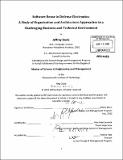| dc.contributor.advisor | Alan MacCormack. | en_US |
| dc.contributor.author | Davis, Jeffrey (Jeffrey Ethan) | en_US |
| dc.contributor.other | System Design and Management Program. | en_US |
| dc.date.accessioned | 2010-10-12T18:49:15Z | |
| dc.date.available | 2010-10-12T18:49:15Z | |
| dc.date.copyright | 2010 | en_US |
| dc.date.issued | 2010 | en_US |
| dc.identifier.uri | http://hdl.handle.net/1721.1/59231 | |
| dc.description | Thesis (S.M. in System Design and Management)--Massachusetts Institute of Technology, Engineering Systems Division, 2010. | en_US |
| dc.description | Cataloged from PDF version of thesis. | en_US |
| dc.description | Includes bibliographical references. | en_US |
| dc.description.abstract | Although large scale software reuse has been studied and practiced in industry for more than 20 years, there are some practice areas where it has presented both technical and business challenges. A sector notable for exhibiting these challenges is defense electronics, the home business arena of the client organization. We have gathered information from academic and broad industry work to compare with the sponsor's experience over the past 15 years. Their organization has built a software reuse program over this time, and benefits from significant exploration of component, module, and software. product line' reuse models. In this context, we try to make sense of and understand patterns of the sponsor's cases, also concentrating on the business and technological environment and the resultant constraints that bound software projects. Our general hypothesis is that success of a reuse program is affected by: project organization type, the team's support and performance, and the design-for-reuse quality of the product. The business success that flows from the reuse program is dependent upon the strategic decisions made with reuse in mind as well as the suitability of the program's structure to the overall business model. In the sponsor's case, this suitability was less than perfect due to the nuances of the defense industry. We draw valuable insights from these cases and present them in a manner useful by similar projects. Further, experience with the product platform technique presents cases that may reveal how it requires the rigor of strict product focus to best serve the business. The main output of this work is to offer conclusions that can be used to shape business area strategy and reuse techniques based on specific conditions of the potential projects or product families. | en_US |
| dc.description.statementofresponsibility | by Jeffrey Davis. | en_US |
| dc.format.extent | 88 p. | en_US |
| dc.language.iso | eng | en_US |
| dc.publisher | Massachusetts Institute of Technology | en_US |
| dc.rights | M.I.T. theses are protected by
copyright. They may be viewed from this source for any purpose, but
reproduction or distribution in any format is prohibited without written
permission. See provided URL for inquiries about permission. | en_US |
| dc.rights.uri | http://dspace.mit.edu/handle/1721.1/7582 | en_US |
| dc.subject | Engineering Systems Division. | en_US |
| dc.subject | System Design and Management Program. | en_US |
| dc.title | Software reuse in defense electronics : a study of organization and architecture approaches in a challenging business and technical environment | en_US |
| dc.type | Thesis | en_US |
| dc.description.degree | S.M.in System Design and Management | en_US |
| dc.contributor.department | System Design and Management Program. | en_US |
| dc.contributor.department | Massachusetts Institute of Technology. Engineering Systems Division | |
| dc.identifier.oclc | 666449210 | en_US |
